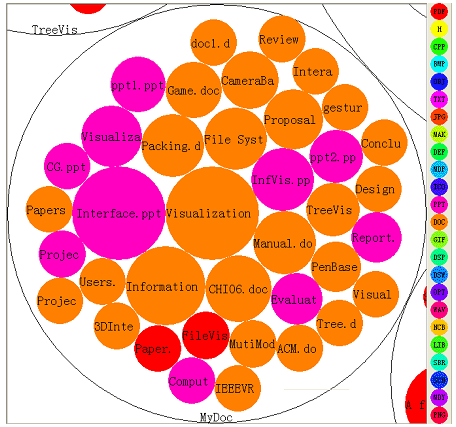Circle Packing: Difference between revisions
No edit summary |
No edit summary |
||
| Line 63: | Line 63: | ||
== Evaluation == | == Evaluation == | ||
Twenty-one students tested the file visualization tool for two weeks. Their feedback | Twenty-one students tested the file visualization tool for two weeks. Their feedback gave a 67 percent positive rating, a 22 percent neutral rating and a 11 percent negative rating. | ||
Revision as of 12:31, 24 April 2007
Authors
- Hongan Wang
- Guozhong Dai
- Weixin Wang
- Hui Wang
Short description
Figures
The tree nodes at different levels are represented by nested circles. Brother nodes are packed into the root node. If a node has children they are packed into it.
Packing circles with random radii. The shape is basically convex.
3D nested cylinders and spheres
Userinterface: directories are represented by white circles.
The Color of the inner circles shows the filetype and the file sizes determine the radii.
Suitable Datatypes
Suitable Datatypes for this visualization technique are (large) hierarchical data structures.
Important Citations
Evaluation
Twenty-one students tested the file visualization tool for two weeks. Their feedback gave a 67 percent positive rating, a 22 percent neutral rating and a 11 percent negative rating.
Mentioned advantages:
- robust and efficient for thousands of files
- friendly interface which is easy to use
- interface needs less operation than traditional files management systems to find a file
- user interface has a high efficiency
- clear bird view of the whole files
- quickly zoom in/out
Mentioned disadvantages:
- difficult to display a long file name fully
- no file names shown in 3D view
- difficult to do copy/paste-operations
Internal Links
External Links
[grokker] Grokker
References
[Wang, W. et al. 2006] Wang et al. Visualization of large hierarchical data by circle packing. In Proceedings of the SIGCHI conference on Human Factors in computing systems, pages 517-520, Montréal, Québec, Canada, 2006: ACM Press.
Evaluation Reference
[Wang, W. et al. 2006] Wang et al. Visualization of large hierarchical data by circle packing. In Proceedings of the SIGCHI conference on Human Factors in computing systems, pages 517-520, Montréal, Québec, Canada, 2006: ACM Press.



